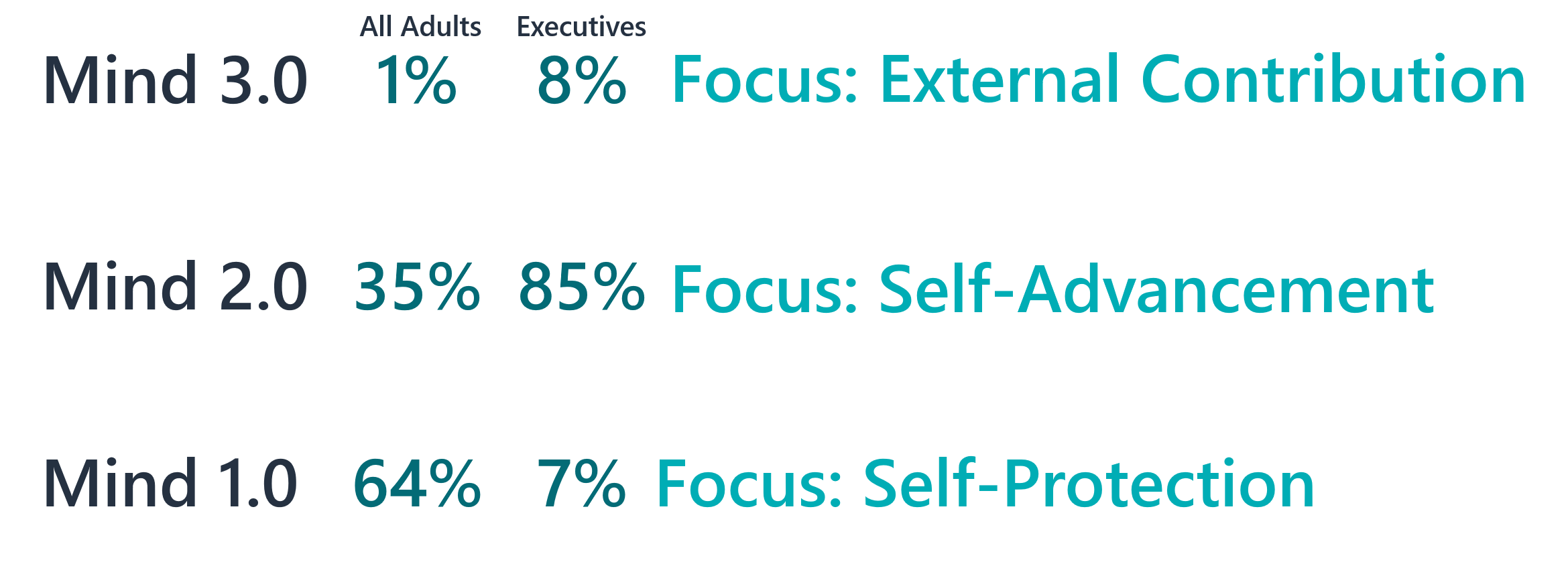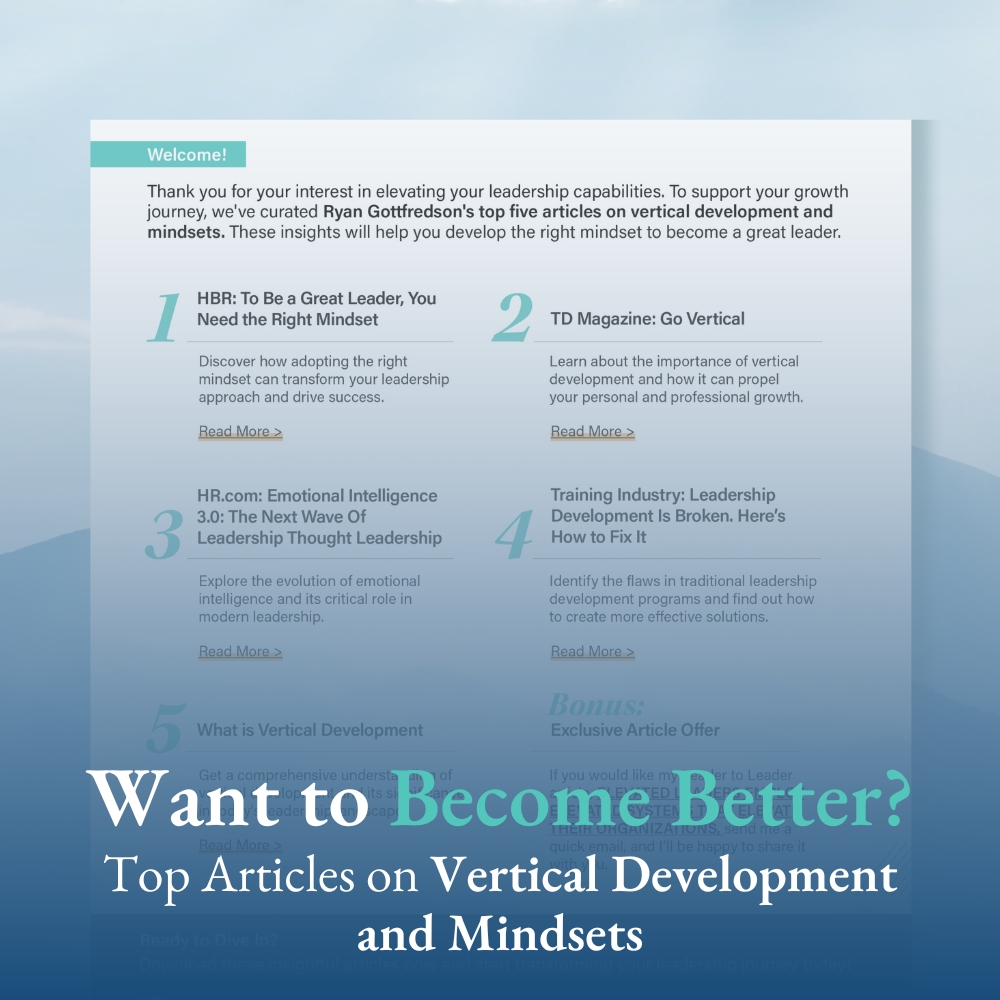It is reasonable to question if transformational vertical development is possible in an organization. I believe that such transformation is rare.
Why is Transformational Change Rare?
I believe that transformational change is rare because the vast majority of people (99% of all adults and 92% of executives) possess an internal operating system that is wired for self-protection.
When someone is wired for self-protection, invitations to change or let go of what we know do not feel like an opportunity to advance or elevate. Instead, it feels dangerous. And, when something feels dangerous, we are going to double down on our self-protection and hold tighter to what we know.
The Two Conditions for Transformational Change?
If we can understand the paragraph above, what starts to become clear is that there are two prerequisites for creating transformational change, both of which involve creating the right environment or conditions for change to occur:
- Upgrading employees’ internal operating system so that they are not wired for self-protective, but wired for organization-advancing (The process of doing this is called vertical development)
- Create an environment where people don’t feel like they need to be self-protective (i.e., create an environment of psychological safety).
Vertical Development
Developmental psychologists have learned that:
- There are three different adult development stages
- Most adults do not develop
- Adult development differs from child development in that adult development is not a function of age, instead, it is a function of investment and effort.
The three adult development stages are as follows:
- Mind 1.0 – We are “good soldiers” programmed to fulfill the needs of safety, comfort, and belonging.
- Mind 2.0 – We are “progress makers” programmed to fulfill the needs of standing out, advancing, and getting ahead (we are willing to be unsafe, uncomfortable, and not belong in order to stand out, advance, and get ahead).
- Mind 3.0 – We are “value creators” programmed to fulfill the needs of contributing, elevating, and lifting others (we are willing to be unsafe and not stand out in order to contribute, elevate, and lift others).
Which of these three internal operating systems is going to embrace change? Which internal operating systems are going to resist change?
Here is the percentage breakdown of adults and executives and where their focus resides:

If we want transformational change, we have got to implement programs to help our employees vertically develop.
Psychological Safety
Google has found that the most important factor that makes their top-performing teams top-performing is psychological safety.
Psychological safety – The belief that one can speak up and take risks without fear of negative repercussions.
If we don’t want employees to be self-protective, we have got to remove reasons for them to be self-protective.
Do you what factors are causing your employees to be self-protective? If not, you won’t be able to create transformational change.
Case Study: Microsoft

The best case study of transformational vertical development of an organization that I have been able to find is Microsoft.
What amazes me about Microsoft is just how quickly Microsoft transformed after Satya Nadella took over as CEO.
I often hear leaders of organizations a fraction of the size of Microsoft state that they feel it is nearly impossible to change the direction, culture, and/or processes of the large “ship” they are captaining. Well, if those organizations are ships, Microsoft might be a continent. Yet, in just a few years, Microsoft transformed to a degree that few large, established companies had ever seen.
Leaders I work with commonly ask me, “How was Microsoft able to transform so quickly?” They want to know if it is something they can replicate.
Fortunately, I do think it is something that all organizations can replicate.
Microsoft emphasized the two prerequisites of transformational change.
Vertical Development
In terms of vertical development, Microsoft did two things:
- They hired a vertically developed CEO in Satya Nadella
- Satya Nadella, from day 1, focused on vertically developing Microsoft employees by helping them upgrade their mindsets. More on this below.
Psychological Safety
As a vertically developed CEO, Nadella implemented policies, practices, and procedures that fostered psychological safety.
Even these policies, practices, and procedures can be replicated.
The first step and the thing at the top of Nadella’s priority list was to develop a new clear and inspiring mission statement for the organization. This was so important to him that, among the thousands of things he could have prioritized during his first year as CEO, he invested a significant amount of time listening to thousands of employees. He understood that a powerful mission statement is most effective if it is generated through the voice of the employees. As mentioned previously, Microsoft ultimately settled on the mission statement: “To empower every person and every organization on the planet to achieve more.”
Second, Nadella understood the foundational role that mindsets play in how employees think, learn, and behave. So, to improve the culture at Microsoft and make it more collaborative, creative, and innovative, he continually emphasized the development of mindsets, particularly growth mindsets. To help Microsoft develop growth mindsets, they did not do anything grand.
They knew that mindsets are like muscles, the more they are exercised, the stronger they become. So, they implemented a lot of small changes that included the following: Nadella hosted a monthly forum where he talked about the things that he learned; employees were encouraged to ask, at the end of meetings, if the meeting had been a growth-minded meeting; on employee badges, they printed the phrase, “Know it all to learn it all;” they put the Chinese symbol for “listen” on all of the elevators, and they established an empathy museum.
Third, Microsoft’s leaders demonstrated their wide window of tolerance for things like failure, being wrong, having problems, and falling behind and created space and safety for those things to occur in their pursuit of greater creativity and innovation.
Here is a great example.
Tay Debacle
In March 2016, Microsoft’s Future Social Experiences Labs unveiled an artificial intelligence chatbot called “Tay.” It was designed to progressively learn and get smarter the more people chatted with it. Unfortunately, the release did not go as planned. Shortly after the launch, people started tweeting the bot with racist and misogynistic remarks. Being a learning device based upon its inputs, Tay began repeating these sentiments back to users. It was garbage in, garbage out. In 24 hours, the bot tweeted 96,000 times in an increasingly vile fashion. It was bad publicity.
Commenting on this launch, one tweeter wrote, “‘Tay’ went from ‘humans are super cool’ to full nazi in <24 hrs and I’m not at all concerned about the future of AI.”

How do you think Steve Ballmer would have responded to this situation? I have a hard time believing that he would respond in the way Satya Nadella responded. Undeterred, Nadella sent a message to Tay’s creators, “Keep pushing, and know that I am with you.”
Nadella understands that when they are pushing the envelope of creativity and innovation, problems and failures are going to happen. And he is okay with that.
Put yourself in the shoes of Tay’s creators. How would Nadella’s response make you feel? I think it would make me feel more committed and empowered.
In December of that same year, Microsoft launched “Zo,” a bot similar to Tay, but designed it to be more troll-resistant.
The moral of this example is that when leaders in an organization elevate vertically, they think in more cognitively and emotionally sophisticated ways, which leads them to make better decisions and implement more cognitively and emotionally sophisticated policies, practices, and procedures. The effect is a rising tide of cognitive and emotional sophistication across the organization.
Creating the Conditions for Transformational Change in Your Organization
Are you:
- Currently trying to create transformational change in your organization, or
- Wanting to create transformational change in your organization?
If so, and if you would like some help focusing on vertical development and creating the conditions for psychological safety, I would love to help.










